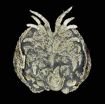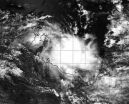(Press-News.org) A portrait of prehistoric parenthood captured deep in the fossil record has been uncovered by an international team of scientists led by University of Leicester geologist Professor David Siveter.
The 'nursery in the sea' has revealed a species new to science – with specimens preserved incubating their eggs together with probable hatched individuals. As a result, the team has named the new species Luprisca incuba after Lucina, goddess of childbirth, and alluding to the fact that the fossils are ancient and in each case the mother was literally sitting on her eggs.
The find, published in the journal Current Biology, provides conclusive evidence of a reproductive and brood-care strategy conserved for at least 450 million years. It also represents the oldest confirmed occurrence of ostracods in the fossil record.
Professor Siveter, Emeritus Professor of Palaeontology at the University of Leicester, said: "This a very rare and exciting find from the fossil record. Only a handful of examples are known where eggs are fossilized and associated with the parent. This discovery tells us that these ancient tiny marine crustaceans took particular care of their brood in exactly the same way as their living relatives."
The team from the UK, USA and Japan has discovered a new and scientifically important species of a fossil ostracod– an animal group related to shrimps, lobsters and crabs - in mudstone rocks from New York State, USA, dating back to the Ordovician period of geological time. Ostracods are tiny crustaceans known from thousands of living species in oceans to rivers, lakes and ponds today and from countless fossil shells.
The newly discovered fossils are two to three millimetres long and are especially informative because they are exceptionally well preserved, complete with not only the shell but also the soft parts of the animal that in all but very rare cases are lost to the fossil record. Limbs and in some specimens a clutch of eggs are present within the bivalved shell, enabling the scientists to identify and gender such specimens. These anatomical features were preserved in the mineral pyrite, which facilitated the use of x-ray techniques to reveal morphological details hidden within the shells and the rock.
Professor Siveter, of the University of Leicester's Department of Geology, together with researchers from the universities of Yale and Kansas, USA, Oxford, UK, and the Japan Agency of Marine Science and Technology, discovered the tiny arthropods.
The ostracods lived, together with other invertebrate animals such as trilobites, in poorly oxygenated conditions in a sea bordering the margins of the ancient North American continent. Professor Siveter said that, like their modern relatives, the ostracods were probably capable of swimming near the sea bed and obtained their food by scavenging and hunting.
INFORMATION: END
Parental care of the young from 450 million years ago
Scientists discover new fossil species revealing parental care of the young from 450 million years ago, and name it after Lucina, goddess of childbirth
2014-03-13
ELSE PRESS RELEASES FROM THIS DATE:
Fossil porpoise has a chin for the ages
2014-03-13
Scientists have identified a new species of ancient porpoise with a chin length unprecedented among known mammals and suggest the animal used the tip of its face to probe the seabed for food.
Related to living crown porpoises, the extinct Californian porpoise, Semirostrum ceruttii, had an extension of its jaw called a symphysis — the analogue of the human chin — that measured 85 centimeters in the best-preserved specimen, researchers said. The typical symphysis of a crown porpoise measures one or two centimeters.
"This is unique anatomy for a mammal," said Rachel Racicot, ...
Scientists catch brain damage in the act
2014-03-13
Scientists have uncovered how inflammation and lack of oxygen conspire to cause brain damage in conditions such as stroke and Alzheimer's disease.
The discovery, published today in Neuron, brings researchers a step closer to finding potential targets to treat neurodegenerative disorders.
Chronic inflammation and hypoxia, or oxygen deficiency, are hallmarks of several brain diseases, but little was known about how they contribute to symptoms such as memory loss.
The study used state-of-the-art techniques that reveal the movements of microglia, the brain's resident ...
Forgetting is actively regulated
2014-03-13
In order to function properly, the human brain requires the ability not only to store but also to forget: Through memory loss, unnecessary information is deleted and the nervous system retains its plasticity. A disruption of this process can lead to serious mental disorders. Basel scientists have now discovered a molecular mechanism that actively regulates the process of forgetting. The renowned scientific journal "Cell" has published their results.
The human brain is build in such a way, that only necessary information is stored permanently - the rest is forgotten over ...
Research findings link post-heart attack biological events that provide cardioprotection
2014-03-13
DALLAS, March 13, 2014 – Heart attack and stroke are among the most serious threats to health. But novel research at UT Southwestern Medical Center has linked two major biological processes that occur at the onset of these traumatic events and, ultimately, can lead to protection for the heart.
On one end of the cascade is the so-called Unfolded Protein Response (UPR), and at the other end are numerous proteins with modified glucose molecules attached to them. For years, researchers have made countless observations relating to these opposite ends of the spectrum. Now, ...
'Super circles' to lessen rush-hour headaches according to Wayne State researchers
2014-03-13
DETROIT— While Mother Nature continues to challenge drivers across the country, a team of traffic engineers is working hard on a new way to make rush-hour commutes safer and faster in any weather.
"We can't do much about snow falling, but we can do something about road capacity and congestion," said Joseph Hummer, traffic engineering expert and Wayne State University College of Engineering chair of civil and environmental engineering.
Hummer and a team of traffic engineers at the Regional Transportation Alliance and North Carolina State University believe metered roundabouts, ...
You should be ashamed -- or maybe not
2014-03-13
(Santa Barbara, Calif.) — Shame on you. These three simple words can temporarily — or, when used too often, permanently — destroy an individual's sense of value and self-worth.
"In modernity, shame is the most obstructed and hidden emotion, and therefore the most destructive," said Thomas Scheff, professor emeritus of sociology at UC Santa Barbara. "Emotions are like breathing — they cause trouble only when obstructed."
When hidden, he continued, shame causes serious struggles not only for individuals but also for groups. In an article published in the current issue ...
NASA sees wind shear affecting Tropical Cyclone Lusi
2014-03-13
Tropical Cyclone Lusi is battling vertical wind shear that has been pushing the bulk of precipitation away from its center. NASA's Terra satellite captured an image of the storm that showed the strongest thunderstorms were being pushed away from the center.
On March 12 at 22:25 UTC/6:25 p.m. EDT, The Moderate Resolution Imaging Spectroradiometer or MODIS instrument that flies aboard NASA's Terra satellite captured a visible image of Tropical Cyclone Lusi in the South Pacific Ocean. The image showed a concentration of thunderstorms just south of the center of circulation.
On ...
NASA sees Tropical Cyclone Gillian's remnants hoping for comeback
2014-03-13
Ex-Tropical Cyclone Gillian weakened to a remnant low pressure area after making landfall in the Western Cape York Peninsula of Queensland, Australia then returned into the Gulf of Carpentaria. NASA's Aqua satellite flew over the tropical low as it struggled to re-intensify.
The MODIS or Moderate Resolution Imaging Spectroradiometer instrument that flies aboard NASA's Aqua satellite captured a visible image of Ex-Tropical Cyclone Gillian moving through Australia's Gulf of Carpentaria on March 13 at 4:25 UTC/12:45 a.m. EDT. Gillian appeared to have moved about two-thirds ...
Prostate specific antigen screening declines after 2012 USPSTF recommendations
2014-03-13
New York, NY, March 13, 2014 – Researchers at Case Western Reserve University and University Hospitals Case Medical Center have assessed the impact of the 2012 U.S. Preventive Services Task Force (USPSTF) recommendations against routine prostate specific antigen (PSA) cancer screenings, which cited evidence that the risks of screening outweigh the benefits. Results of the current study indicate that the USPSTF recommendations have resulted in a decrease in the number of PSA screenings ordered by doctors, with the greatest decline seen among urologists. The findings are ...
Performing cardio and resistance training during the same session: Does the order matter?
2014-03-13
Although the remarkable benefits of combined training have been clarified by numerous investigations, fitness enthusiasts struggle with the same question: Does the order of cardio- and resistance training influence the effectiveness of a training program?
This question has now been the focus of a series of investigations in the Department of Biology of Physical Activity at the University of Jyväskylä. The international research group led by Professor Keijo Häkkinen and coordinated by PhD student Moritz Schumann has recruited a total of almost 200 recreationally active ...
LAST 30 PRESS RELEASES:
First ‘Bible map’ published 500 years ago still influences how we think about borders
Why metabolism matters in Fanconi anemia
Caribbean rainfall driven by shifting long-term patterns in the Atlantic high-pressure system, study finds
Potential treatment to bypass resistance in deadly childhood cancer
RSV vaccines could offer protection against asthma
Group 13 elements: the lucky number for sustainable redox agents?
Africa’s forests have switched from absorbing to emitting carbon, new study finds
Scientists develop plastics that can break down, tackling pollution
What is that dog taking? CBD supplements could make dogs less aggressive over time, study finds
Reducing human effort in rating software
Robots that rethink: A SMU project on self-adaptive embodied AI
Collaborating for improved governance
The 'black box' of nursing talent’s ebb and flow
Leading global tax research from Singapore: The strategic partnership between SMU and the Tax Academy of Singapore
SMU and South Korea to create seminal AI deepfake detection tool
Strengthening international scientific collaboration: Diamond to host SESAME delegation from Jordan
Air pollution may reduce health benefits of exercise
Ancient DNA reveals a North African origin and late dispersal of domestic cats
Inhibiting a master regulator of aging regenerates joint cartilage in mice
Metronome-trained monkeys can tap to the beat of human music
Platform-independent experiment shows tweaking X’s feed can alter political attitudes
Satellite data reveal the seasonal dynamics and vulnerabilities of Earth’s glaciers
Social media research tool can lower political temperature. It could also lead to more user control over algorithms.
Bird flu viruses are resistant to fever, making them a major threat to humans
Study: New protocol for Treg expansion uses targeted immunotherapy to reduce transplant complications
Psychology: Instagram users overestimate social media addiction
Climate change: Major droughts linked to ancient Indus Valley Civilization’s collapse
Hematological and biochemical serum markers in breast cancer: Diagnostic, therapeutic, and prognostic significance
Towards integrated data model for next-generation bridge maintenance
Pusan National University researchers identify potential new second-line option for advanced biliary tract cancer
[Press-News.org] Parental care of the young from 450 million years agoScientists discover new fossil species revealing parental care of the young from 450 million years ago, and name it after Lucina, goddess of childbirth






